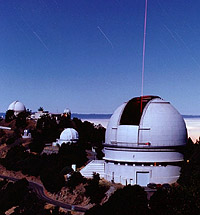![[Currents header graphic]](/homeart/currents_header.gif)
![[Currents header graphic]](/homeart/currents_header.gif)
March 15, 1999
By Tim Stephens
A committee from the National Science Foundation (NSF) visited UCSC late last month to evaluate a proposal to create a national Center for Adaptive Optics on campus. The center would coordinate the efforts of researchers across the country working in the exciting new field of adaptive optics, which has major applications in astronomy and vision science.

|
|
The adaptive optics system at Lick Observatory on Mount Hamilton uses a
laser beam to measure turbulence in the atmosphere.
Photo: UCO/Lick Observatory |
Adaptive optics is a method to actively compensate for changing distortions that cause blurring of images. Turbulence in the earth's atmosphere causes blurring of astronomical images obtained by ground-based telescopes. Similarly, internal imperfections and small motions in the eye result in blurred vision and also interfere with efforts to study the living human retina.
UC astronomers are leaders in the development of new astronomical instruments, including adaptive optics systems for telescopes. Jerry Nelson, professor of astronomy and astrophysics at UCSC, would direct the Center for Adaptive Optics and is spearheading the effort to obtain NSF funding.
"For astronomy, adaptive optics on large telescopes promises spectacular improvement in resolution, making images 10 to 30 times sharper," Nelson said.
Adaptive optics is also a powerful tool for understanding the structure and development of the human retina and may enable early detection of tiny retinal defects before they become large enough to threaten a person's vision.
But the complexity of adaptive optics has thus far prevented its routine use. Several highly advanced technologies must be melded to create an adaptive optics system, including precision optics, sensors, deformable mirrors, and lasers. High-speed computer hardware and sophisticated software systems are needed to integrate and control these technologies.
First-generation adaptive optics systems have been developed and are being used for astronomical observations at Lick Observatory and other sites. But the field is still in its infancy, Nelson said.
"To bring this technology to maturity and make complex AO systems practical tools for science will require a coherent national program that brings together scientists and engineers with very different areas of expertise," Nelson said.
This is the type of interdisciplinary challenge that NSF's Science and Technology Centers are meant to address. NSF is expected to fund eight to ten new Science and Technology Centers this year. Out of 43 proposals from a broad range of fields, the Center for Adaptive Optics was among 16 serious contenders chosen by NSF for site visits and further evaluation. The proposed budget for the Center for Adaptive Optics totals nearly $20 million over five years.
During the two-day site visit, the 15-person NSF committee heard Nelson and many other scientists make the case for funding an adaptive optics Science and Technology Center at UCSC. The committee also toured the UCO/Lick Laboratories, where they witnessed simulations of adaptive optics systems at work in both astronomy and vision science applications.
In addition to Nelson, the executive committee of the proposed center includes Marc Davis at UC Berkeley, Andreas Quirrenbach at UC San Diego, James Larkin at UCLA, Bernard Sadoulet at UC Berkeley, David Williams at the University of Rochester, and Claire Max at Lawrence Livermore National Laboratory.
Collaborators from many other institutions will also be involved in the center's activities. In vision science, for example, academic partners will include researchers in the Center for Visual Science and the Institute of Optics at the University of Rochester, the College of Optometry at the University of Houston, and Don Miller at Indiana University.
"The Center for Adaptive Optics would unify the various subfields of adaptive optics into a coherent, integrated program with a national scope," Nelson said.
Industry partnerships will also be important for developing practical new devices and implementing adaptive optics applications in healthcare and other fields. Bausch and Lomb, Erin International, and Lucent Technologies are among the center's industrial partners.
Science education and outreach will also be an important component of the center. Partnerships are planned with public schools and institutes such as the Chabot Observatory and Science Center in Oakland. The Center for Adaptive Optics will also support undergraduate and graduate education through a variety of programs.
A decision from NSF regarding funding for the center is expected in early August.